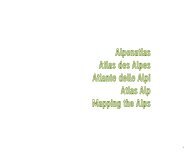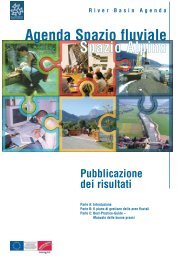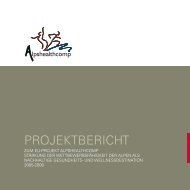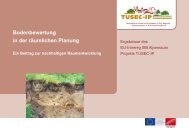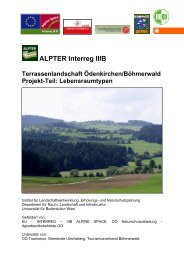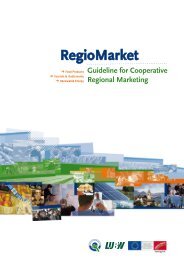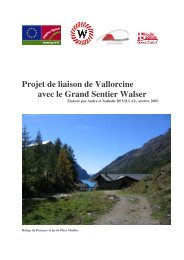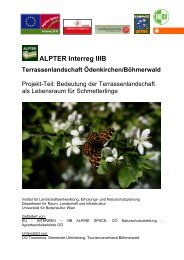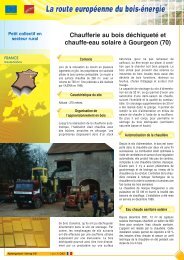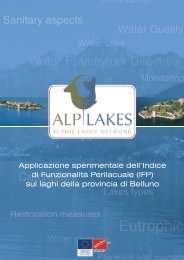1.2 - INTERREG IIIB Alpine Space Programme
1.2 - INTERREG IIIB Alpine Space Programme
1.2 - INTERREG IIIB Alpine Space Programme
You also want an ePaper? Increase the reach of your titles
YUMPU automatically turns print PDFs into web optimized ePapers that Google loves.
72<br />
environment and cultural heritage<br />
Lead partner<br />
Zentralanstalt für Meteorologie<br />
und Geodynamik,<br />
Regionalstelle für Salzburg<br />
und Oberösterreich<br />
Other partners<br />
ZAMG Steiermark<br />
ZAMG Kärnten<br />
ZAMG Tirol und Vorarlberg<br />
ARPA Veneto<br />
ARPA FVG<br />
Provincia A. di Trento<br />
Hydro Bz<br />
ARPA Lombardia<br />
Regione Piemonte<br />
Regione A. Valle d´Aosta<br />
MeteoSwiss<br />
Deutscher Wetterdienst<br />
ARSO<br />
Project website<br />
www.meteorisk.info<br />
Contact person<br />
Michael Staudinger<br />
Tel +43 (0)662 626301 24<br />
Fax +43 (0)662 625838<br />
Staudinger@zamg.ac.at<br />
Duration<br />
0<strong>1.2</strong>003 – 06.2006<br />
Total budget in EUR<br />
1.901.684<br />
ERDF in EUR<br />
928.000<br />
Lead partner<br />
Project partner<br />
A<br />
A<br />
A<br />
A<br />
I<br />
I<br />
I<br />
I<br />
I<br />
I<br />
I<br />
CH<br />
D<br />
SI<br />
3.3<br />
METEORISK<br />
Mitigation of natural risks through improved forecasting<br />
of extreme meteorological events<br />
Coordination of weather warnings in the Alps with improved means of data acquisition and cooperation of weather services.<br />
Aim<br />
Extreme meteorological events originate in one part of the<br />
Alps and proceed over or along the <strong>Alpine</strong> crest. The effects of<br />
these events are inundations, landslides, avalanches, which<br />
do not occur outside of the Alps. Forecasting is limited by the<br />
lack of structured communication between the weather services<br />
in these areas and the lack of online available data.<br />
Objectives of the project were:<br />
To create an online network of automatic meteorological stations<br />
The improved interpretation of different regional models.<br />
Optimised communication and networking between forecasters<br />
The improvement of the interaction between the civil protection<br />
authorities and the public<br />
Activities<br />
The weather services of the 14 partner regions from the Vienna<br />
Woods and the Po Valley to the Zugspitze and the Swiss<br />
mountain peaks have brought more than 70 scientists and<br />
forecasters together. METEORISK coordinates warnings in<br />
high mountain areas and around them. In the case of severe<br />
weather telephone conferences and GIS Internet applications<br />
are used to publish together the best results of forecasting<br />
available throughout Europe.<br />
Additionally new automatic weather stations, which include<br />
the most advanced X-band radar systems, were built in the<br />
areas that had little data coverage beforehand. A couple of<br />
hundred automatic weather stations of other providers like<br />
avalanche or environment services were integrated into the<br />
system. Despite all the digital and logistical complexity behind<br />
it, this website stands out for being easy to use, even for beginners<br />
and lay users.<br />
Outcomes and results<br />
Within the weather services on all sides of the Alps the improvement<br />
of the infrastructure has already led to a sustainable<br />
optimisation of the forecast abilities and the transnational<br />
communication facilities. The co-ordinated forecasting of<br />
meteorological features in regions that cover more than one<br />
forecast area with the help of different models has already<br />
helped to mitigate the consequences of natural hazards and<br />
disasters. The best example were the floods in Switzerland<br />
and the western parts of Austria in the summer of 2005, where<br />
forecast across the borders of Switzerland and Austria had<br />
been coordinated and homogenised.<br />
The number of stations accessible to the METEORISK forecasters<br />
has increased to more than 1500 in February 2006.<br />
Most of these stations are not owned by the weather services,<br />
but part of the network is made available by avalanche services,<br />
environmental protection agencies and energy suppliers.<br />
It is planned, that certain parts of the partnership, like tel-<br />
ephone conferences under critical meteorological conditions<br />
in order to improve the forecast skill through the exchange of<br />
experience will continue unchanged after the closure of the<br />
project. Infrastructure like databanks and software tools will<br />
be used by all partners in the future.<br />
The extension of the applied techniques to other regions will<br />
be part of the coherence and integration processes within the<br />
weather services. The project EMMA (European Multipurpose<br />
Meteorological Awareness) initiated by EUMENET, the association<br />
of the European weather services, follows the ideas<br />
developed within METEORISK.



